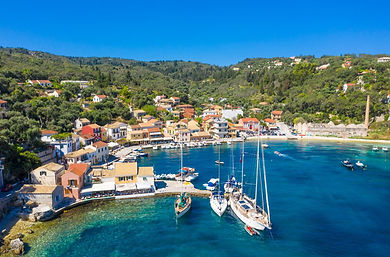Paxos, the cutest baby of the Ionian Islands, is a cluster of small islands and rocky islets,
the largest of which are Paxi and Antipaxos.


Paxos Towns



The capital of Paxos is Gaios, a picturesque village built around a natural port that is created by the islet St Nicolas. Gaios, which has retained its elegant Venetian architecture, is the most cosmopolitan and full of life. Here you can find the best cocktail on the island (dm us to give you the tip) such as beautiful taverns with Greek and Italian traditional cuisine.
At the northern tip of the island sits beautiful Lakka, the second in size. More quiet and elegant, Lakka is an excellent choice for a late swim and an aperitif.
On the east coast nestles the charming village of Loggos, a romantic treat for the refined palate. In Loggos, you can find some of the best restaurants.
Speaking about "best restaurants" we could not forget the tiny village of Magazia. Magazia, competing with Loggos, has some excellent choices for food and a big variety for its size...
Sail, Swim, Sunbathe
If you’re looking for the ultimate relaxation destination, the eastern coastlines of Paxos are smooth and ideal for you. Head to the beach and enjoy the crystal-clear blue waters. Sunbathe, it’ll feel therapeutic.
If you are more of an adventurer, the west coast will speak to your heart! Bold and abrupt, the west coastlines are full of remarkable natural formations: Ypapanti, Achai, and other caves, arches, dome-shaped forms, the Erimitis sheer cliffs, and more.
Don't forget Antipaxos, which is also full of surprises! One of them is that you can't bring your car nor your scooter. You can reach the island only by boat. Vrika and Vοutoumi are the two most famous beaches with the easiest access. At both of the beaches, you’ll find beach taverns with sunbeds and umbrellas. It is quite exotic out there! The bright blue, transparent waters, the white sand, and the thick, green background create scenery that reminds the Caribbean.
If you are brave enough to rent a boat by yourself, sail around both islands...you will need a boat to explore all the secret gems.


Paxos olive groves

Paxos is an island of endless olive groves. The island is totally covered by them. There are an estimated 300,000 olive trees on Paxos which were introduced by the Venetians in the 16th century, and it is said that the Paxiots were offered the equivalent of 5 drachmas for every olive tree they planted. Till today, Paxiots use the ancient stone presses to crush the olives and produce oil.
Did you know that Greeks consume more olives than any other people in Europe (Paxiots being no exception) ??
Antipaxos vineyards
Antipaxos is one large vineyard
The combination of the archipelago’s winemaking traditions and the high-quality grape varieties produces sumptuous wine – the elixir of the Gods! The 50 inhabitants of the island are very proud of their local wine, which can be bought in some stores in Paxos. Our advice...Buy it! You are going to get thrilled!

Sightseeing in Paxos





A day in Gaios doesn't include only good bars and restaurants or a good market. There is history and tradition that await you to discover.
George Anemogiannis' statue is a piece of art and a symbol for the island. It represents a hero, born in 1798 in Paxos. At the time of the Greek Revolution in 1821, he was a sailor on a merchant ship. The same year, he took part in one of the first naval attacks against the Ottoman Empire, as the skipper of a fire ship. During the attack, he was arrested and executed by the authorities. His dead body was hung for several days as an example to other rebels. Today, there are two monuments in his honor, one in Nafpaktos, the place where he was tortured and executed, and one at his birthplace in Paxos. The monument at Paxos was crafted in 1966, a work by sculptor Nikolas Pavlopoulos.
The Da Vinci castle of Paxos, now known as the castle of Saint Nicholas, has its roots back in the 15th century. Built on top of the homonymous natural island opposite Gaios, it was constructed to protect from pirates and Ottomans. Today, most of the walls remain intact, like the gunpowder magazine, the tank, the observatory, the cannons, several utility rooms, and the deep well that still has water.
The Historical and Folklore Museum of Paxos in Gaios is housed in a traditional building of an old school from 1906.
Visit the museum to see the special selection with fossils, pieces of pottery, weapons, books, traditional furniture, cooking utensils, agricultural tools, costumes, and other items from Prehistoric, Classical, Roman, and Venetian times.
If you are passionate about Greek olive oil, you can visit the Olive Museum in Magazia. Learn the secrets of traditional oil production, as well as the cultural history of Paxos.
During the Venetian times, most of the churches on Paxos were built. With the exception of Agia Marina and Agios Stefanos, now in ruins, date back to the 6th century AD. These two churches are in Ozias, the oldest settlement on the island. One of the most unusual churches, with a beautiful bell tower, is that of Ipapanti, near Lakka. Another church to pay your respects to is Agii Apostoli, with wonderful views of the Erimitis Cliffs. In the same area, the church of Ag. Charalambos is noted for an ancient icon of the Virgin.
Activities in Paxos
Our island is an amazing place to visit and there is plenty of beauty to admire, but to do so, you need the right way.
From bike, scooter, and car hire to canoe, boat, and RIB rental, sea trips, scuba diving, yoga, and organized hiking, Paxos offers a complete experience that can take place from May to October. Find our guide in our studios and make your holiday much simpler.


